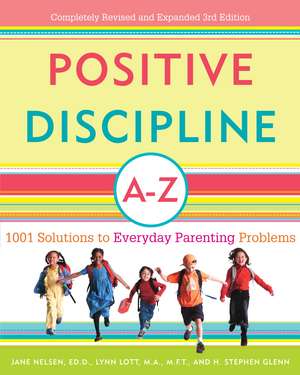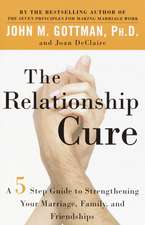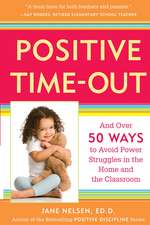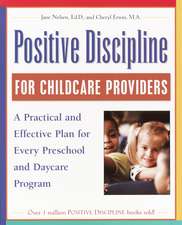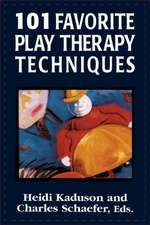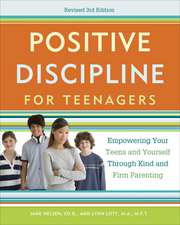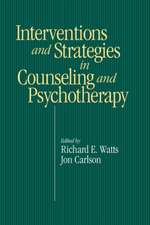Positive Discipline A-Z: 1001 Solutions to Everyday Parenting Problems: Positive Discipline Library
Autor Jane Nelsen, Lynn Lott, H. Stephen Glennen Limba Engleză Paperback – 28 feb 2007
- Sibling Rivalry
- Bedtime Hassles
- School Problems
- Getting Chores Done
- ADHD ·Eating Problems
- Procrastination
- Whining
- Tattling and Lying
- Homework Battles
- And Dozens More!
This newly revised and expanded third edition contains up-to-the-minute information on sleeping through the night, back talk, and lack of motivation as well as tips on diet, exercise, and obesity prevention, and new approaches to parenting in the age of computers and cell phones.
Preț: 99.14 lei
Nou
Puncte Express: 149
Preț estimativ în valută:
18.97€ • 19.85$ • 15.76£
18.97€ • 19.85$ • 15.76£
Carte disponibilă
Livrare economică 13-27 martie
Preluare comenzi: 021 569.72.76
Specificații
ISBN-13: 9780307345578
ISBN-10: 0307345572
Pagini: 316
Ilustrații: 47 LINE DRAWINGS
Dimensiuni: 188 x 234 x 19 mm
Greutate: 0.41 kg
Ediția:Revised
Editura: Three Rivers Press (CA)
Seria Positive Discipline Library
ISBN-10: 0307345572
Pagini: 316
Ilustrații: 47 LINE DRAWINGS
Dimensiuni: 188 x 234 x 19 mm
Greutate: 0.41 kg
Ediția:Revised
Editura: Three Rivers Press (CA)
Seria Positive Discipline Library
Notă biografică
Jane Nelsen, Ed.D., is a licensed marriage, family, and child therapist, and an internationally known speaker. Lynn Lott, M.A., M.F.T., is a therapist and author of more than eighteen books and manuals. H. Stephen Glenn, Ph.D., coauthored the bestselling classics Raising Self-Reliant Children in a Self-Indulgent World and 7 Strategies for Developing Capable Students.
Extras
Chapter 1
1
What Is Positive Discipline?
As a parent you have a big job. You’re the one who helps your children grow up to feel a sense of belonging and connection to the family. You teach your children social and life skills. You help your children feel loved. You find ways to ensure that your children feel special, unique, and important. You keep your children safe.
How do you do that? With discipline. Perhaps you think of “discipline” as a means of control through punishment, but Positive Discipline is not about punishment or control. Rather it is about instructing, educating, preparing, training, regulating, skill building, and focusing on solutions. Positive Discipline is constructive, encouraging, affirming, helpful, loving, and optimistic. As children don’t come with directions, parents need to find an approach that gives them a sense of confidence.
Positive Discipline begins at birth and lasts a lifetime. That’s right, it’s never too early or too late to use Positive Discipline, because it is based on mutually respectful relationships in which you respect your child and you respect yourself. If parenting advice focuses only on the needs of the child and not the needs of the adults, it isn’t mutually respectful. That kind of parenting encourages dependence and a lack of courage. If parenting advice focuses only on the needs of the adult and not the needs of the children, that’s also not mutually respectful—it encourages submission, fear, and rebellion.
With Positive Discipline, the emphasis is on a balance of firmness and kindness, and on providing respect for both adults and children. Positive Discipline, because it is neither permissive nor punitive, brings hope, increased skills, and love to your family.
The more tools you have, the more you can teach your children. Part 1 is a reference to give you an understanding of the twenty-seven basic tools of Positive Discipline. These twenty-seven tools are referred to throughout the book, so be sure to read Part 1 before starting on the specific problems.
Be Kind and Firm
Many parents are plagued with guilt. That’s because they are either too controlling (“I’m the boss”) or too permissive (“Call me milquetoast”). Some parents are a combination of controlling and permissive, vacillating between the two extremes but not being consistent. Positive Discipline parents are neither. They practice firmness coupled with kindness. Which of the following styles fits for you?
The Boss: You have all the power and your kids should obey you simply because you’re the parent.
Milquetoast: Your children are the center of the universe, so they have all the power.
Kind and Firm: Your child is part of your family, not the center of the universe. You know your child’s personality and can create boundaries without breaking your child’s spirit.
Still not sure which is your style? Here are more clues. Both the boss and milquetoast act instead of being proactive. That means that they wait till something happens and respond to it in the moment. Kind and Firm parents take a step back, observe and think before they act. They work on ways to show their child what to do instead of constantly saying YES! or NO! The Boss often looks for blame or fault and relies on punishment as the primary discipline tool. Kind and Firm parents look for solutions instead of blame and realize that the person who can and must change first is the parent. By changing yourself even in the smallest ways, you can positively influence your child’s behavior.
Milquetoast parents spend a lot of energy on what they shoulda, coulda, or woulda done. They tend to feel sorry for their children when they mess up, and are unwilling to let a child learn from his or her behavior. If this is your style, your child is parenting you instead of you providing leadership for the family. You are overprotective and you lack faith in your child’s ability to learn and grow. You are not giving your child many opportunities to develop the belief “I am capable.” Guilt is your middle name.
When you use the tools of Positive Discipline, you become the Kind and Firm parent, and you banish guilt from your life. You give yourself and your child permission to make mistakes, to be imperfect, and to try again, and again, and again. Why? Because you know that mistakes are the best teacher and that it is human to make them.
Kind and Firm parenting happens one step at a time. Reflect on your strengths and the strengths of your family. Then think of the areas you’d like to improve, and work on one issue at a time. That way you won’t overwhelm yourself or your children.
Decide What You Will Do,
and Then Do It
The heart of Positive Discipline is learning to change yourself instead of trying to control others and make them change. If you’ve been busy trying to control your children, you probably haven’t considered the possibility that you can deal with problems by controlling your own behavior and deciding what you will do instead of what you will try to make your children do.
Once you begin to focus on changing your behavior, you soon realize that actions must accompany your words and you have to follow through on your decisions. So that you don’t paint yourself into any corners, it’s best to think before you open your mouth. Rather than saying things you don’t really mean and finding yourself in the middle of the muddle, take a step back, and give the matter your full attention. This will help you ignore minor interruptions and deal with the ones that are really important to you.
Here are some examples of “Deciding What You Will Do” in action:
•A mother of an eleven-month-old baby who struggled through diaper changing decided to stop fighting with her child. Instead she said, “I need your help. I’ll wait till you are ready to lie still while I change your diaper.” Each time her child struggled, she stopped, and without speaking, waited quietly until her baby stopped wiggling. The minute the wiggles stopped, she went back to the diaper change. It took a few times before her child started to help with the process and stay still. She showed no anger, but simply waited patiently, keeping her child safe on the changing table.
•Another parent found that she was repeating herself all the time, and she realized that no one seemed to be listening to her. After some thought, she told her children that she would make sure she had their full attention and then say things one time. If they had questions, she’d be happy to answer them, but she was no longer going to repeat herself. She stuck to her guns, and soon noticed how much better her children listened when she said something. If they weren’t paying attention, they would ask one of their siblings what Mom had said.
•A parent noticed that his kids were putting off their homework until just before bedtime, and then asking for help. He told them he would be available to help with homework every night between seven and nine. The first time one of his kids came to him at 9:30 to start studying for a test, he smiled and said, “I know you need my help, and I am happy to help you between seven and nine any night of the week. This time you’re on your own.” It is so easy for a parent to feel sorry for a child at this point, or think it is best to give more chances (after the “I told you so” lecture). But you can make the problem much better if you have the courage to follow through on your commitment, because you are allowing your child to learn from her behavior. Keep in mind that this only works if you skip the nagging, reminding, and lectures.
•Many parents have learned how to avoid unsafe driving by pulling the car to the side of the road and waiting quietly until the children settle down. Shopping trip tantrums have been avoided when parents take their children to sit in the car the moment the whining or tantrums start. All the parent says is, “We’ll go back as soon as you are ready.” Others have sidestepped fights and crying jags by clearly stating that they don’t make loans and sticking to it, allowing their children to learn to budget their allowance. Saying and meaning that the car doesn’t move until everyone is buckled safely into the seat belt puts a stop to endless power struggles.
It’s very tempting to repeat yourself, remind, and explain instead of following through with action. Kind and Firm parents save their words to talk about how wonderful their children are, or to engage in conversations about interesting topics, or to explain how life works.
Act, Don’t Talk
Another variation on the “decide what you will do” method of parenting is to act instead of talking. Listen to yourself for one day. You might be amazed how many useless words you say. Or listen to parents bargaining with their kids at the grocery store, begging them at the department store, nagging them at the park, and explaining endlessly to them when it’s time to move from point A to point B. Over 75 percent of the problems parents have with young children would probably disappear if parents talked less and acted more. Children tune parents out because parents talk too much.
This parenting by words (“Do this” “Don’t do that”) is a way parents mistakenly turn power over to children who tune them out and don’t do a thing they say. These parents then label their children as disobedient instead of acknowledging that they themselves are not using effective parenting skills. It is perfectly okay to take children by the hand and start walking, or lift them up and carry them to bed, or set them in the tub when they are having a fit about taking a bath. It is disrespectful to yell, nag, lecture, beg, order, and threaten. Give up counting to three; just zip your lips and act. You’ll be amazed at the results.
If you decide to act more and talk less, your children will begin to notice the difference. Instead of asking your children to be quiet over and over, you can try waiting quietly for them to give you their attention. If children are fighting over a toy, quietly remove it and put it where they can’t reach it. You don’t need to say a word for them to get the idea that they can have the toy back when they stop fighting over it. If your child is banging his fork on the table or reaching for an object you don’t want the child to have, ask the child to stop once. If the child persists, remove the object instead of repeating yourself incessantly.
Here’s the biggest “parenting by words” mistake—asking your children if they would like to do something that you know they need to do. You’ve done it, and you’ve heard it from other parents. “Would you like to buckle up your seat belt?” “Would you like to come to dinner?” “Would you like to make your bed?” The answer is usually “No, no, no!”
To avoid this problem say instead: “It’s time to buckle your seat belt.” “It’s dinnertime.” “We make our beds before we leave the house.” “Thursday is the day we wash our sheets.” “Here’s what we need to do. We pick up the dishes and bring them to the dishwasher when we’re done eating.” If you practice talking to your children this way when they are young, there are many things that they will accept as the way things are done in their family. They won’t challenge the decisions, because that’s the way it is, and not everything has to be a debate or a discussion.
Another act-don’t-talk tip is to make sure you are in the same room before you make requests of children. If you can see the whites of their eyes and establish eye contact with them, you have a better chance of getting through. You have to get their attention before children can hear what you have to say. Action is a great tool for this. Notice how much quicker you get results if you stand up or move toward your children while you are talking instead of sitting in an armchair yelling instructions across the room.
Use Follow-Through
Follow-through can greatly reduce frustration and conflict with children while teaching them many valuable life skills. Follow- through is a form of action and a powerful way to get your children to listen and cooperate. When you use follow-through, you are being extremely proactive as a parent.
Here’s how follow-through works. Instead of jumping into the middle of a problem, you watch for the patterns and then pick your battles. When you decide you are ready to improve a situation, follow these steps:
1.Give the matter your full attention;
2.Acknowledge your child’s feelings and grant the child his wish in fantasy (“I wish we could give you what you want”);
3.Tell your child what to do instead of what not to do or,
4.Work out a solution with your child’s help;
5.Say how you feel and set your limit;
6.Follow-through with action.
Here’s an example of follow-through. Shelly bugged her mom every time she tried to talk on the phone. Even though her mom gave her a turn to talk to the caller, Shelly persisted in begging to talk more or longer, and if she couldn’t, she pinched, bit, and hit her mother. Mom decided to give the matter her full attention since the problem was reoccurring. She thought about choices she could follow through on. She picked a time when there were no phone calls and said to Shelly, “I know you wish you could have my attention or talk to the people who call here. I understand, and I wish you could talk as long as you like, but that’s not always possible.”
Then she asked Shelly if she had any suggestions of how to be more helpful when Mom needed to talk uninterrupted. Shelly said, “I want to talk and I don’t want you to talk instead of playing with me.” Once more Mom said, “I understand how you feel, but here’s what we need to do. When I answer the phone, I’ll let you know if it is someone you can talk to. If it’s not, please color in your book or play with your Legos until I’m off the phone. I know it might be hard to wait, but I have faith that you can do it and help me out so I can finish my calls. I feel upset when I am trying to talk to someone and I can’t concentrate because you want my attention.”
Then Mom told Shelly exactly what would happen and set her limit. “Shelly, if it’s too hard for you to wait, I understand, but I need to feel safe while I’m on the phone. If I don’t feel safe because you are biting or hitting me, I’ll take the phone out on the deck and finish my call.”
1
What Is Positive Discipline?
As a parent you have a big job. You’re the one who helps your children grow up to feel a sense of belonging and connection to the family. You teach your children social and life skills. You help your children feel loved. You find ways to ensure that your children feel special, unique, and important. You keep your children safe.
How do you do that? With discipline. Perhaps you think of “discipline” as a means of control through punishment, but Positive Discipline is not about punishment or control. Rather it is about instructing, educating, preparing, training, regulating, skill building, and focusing on solutions. Positive Discipline is constructive, encouraging, affirming, helpful, loving, and optimistic. As children don’t come with directions, parents need to find an approach that gives them a sense of confidence.
Positive Discipline begins at birth and lasts a lifetime. That’s right, it’s never too early or too late to use Positive Discipline, because it is based on mutually respectful relationships in which you respect your child and you respect yourself. If parenting advice focuses only on the needs of the child and not the needs of the adults, it isn’t mutually respectful. That kind of parenting encourages dependence and a lack of courage. If parenting advice focuses only on the needs of the adult and not the needs of the children, that’s also not mutually respectful—it encourages submission, fear, and rebellion.
With Positive Discipline, the emphasis is on a balance of firmness and kindness, and on providing respect for both adults and children. Positive Discipline, because it is neither permissive nor punitive, brings hope, increased skills, and love to your family.
The more tools you have, the more you can teach your children. Part 1 is a reference to give you an understanding of the twenty-seven basic tools of Positive Discipline. These twenty-seven tools are referred to throughout the book, so be sure to read Part 1 before starting on the specific problems.
Be Kind and Firm
Many parents are plagued with guilt. That’s because they are either too controlling (“I’m the boss”) or too permissive (“Call me milquetoast”). Some parents are a combination of controlling and permissive, vacillating between the two extremes but not being consistent. Positive Discipline parents are neither. They practice firmness coupled with kindness. Which of the following styles fits for you?
The Boss: You have all the power and your kids should obey you simply because you’re the parent.
Milquetoast: Your children are the center of the universe, so they have all the power.
Kind and Firm: Your child is part of your family, not the center of the universe. You know your child’s personality and can create boundaries without breaking your child’s spirit.
Still not sure which is your style? Here are more clues. Both the boss and milquetoast act instead of being proactive. That means that they wait till something happens and respond to it in the moment. Kind and Firm parents take a step back, observe and think before they act. They work on ways to show their child what to do instead of constantly saying YES! or NO! The Boss often looks for blame or fault and relies on punishment as the primary discipline tool. Kind and Firm parents look for solutions instead of blame and realize that the person who can and must change first is the parent. By changing yourself even in the smallest ways, you can positively influence your child’s behavior.
Milquetoast parents spend a lot of energy on what they shoulda, coulda, or woulda done. They tend to feel sorry for their children when they mess up, and are unwilling to let a child learn from his or her behavior. If this is your style, your child is parenting you instead of you providing leadership for the family. You are overprotective and you lack faith in your child’s ability to learn and grow. You are not giving your child many opportunities to develop the belief “I am capable.” Guilt is your middle name.
When you use the tools of Positive Discipline, you become the Kind and Firm parent, and you banish guilt from your life. You give yourself and your child permission to make mistakes, to be imperfect, and to try again, and again, and again. Why? Because you know that mistakes are the best teacher and that it is human to make them.
Kind and Firm parenting happens one step at a time. Reflect on your strengths and the strengths of your family. Then think of the areas you’d like to improve, and work on one issue at a time. That way you won’t overwhelm yourself or your children.
Decide What You Will Do,
and Then Do It
The heart of Positive Discipline is learning to change yourself instead of trying to control others and make them change. If you’ve been busy trying to control your children, you probably haven’t considered the possibility that you can deal with problems by controlling your own behavior and deciding what you will do instead of what you will try to make your children do.
Once you begin to focus on changing your behavior, you soon realize that actions must accompany your words and you have to follow through on your decisions. So that you don’t paint yourself into any corners, it’s best to think before you open your mouth. Rather than saying things you don’t really mean and finding yourself in the middle of the muddle, take a step back, and give the matter your full attention. This will help you ignore minor interruptions and deal with the ones that are really important to you.
Here are some examples of “Deciding What You Will Do” in action:
•A mother of an eleven-month-old baby who struggled through diaper changing decided to stop fighting with her child. Instead she said, “I need your help. I’ll wait till you are ready to lie still while I change your diaper.” Each time her child struggled, she stopped, and without speaking, waited quietly until her baby stopped wiggling. The minute the wiggles stopped, she went back to the diaper change. It took a few times before her child started to help with the process and stay still. She showed no anger, but simply waited patiently, keeping her child safe on the changing table.
•Another parent found that she was repeating herself all the time, and she realized that no one seemed to be listening to her. After some thought, she told her children that she would make sure she had their full attention and then say things one time. If they had questions, she’d be happy to answer them, but she was no longer going to repeat herself. She stuck to her guns, and soon noticed how much better her children listened when she said something. If they weren’t paying attention, they would ask one of their siblings what Mom had said.
•A parent noticed that his kids were putting off their homework until just before bedtime, and then asking for help. He told them he would be available to help with homework every night between seven and nine. The first time one of his kids came to him at 9:30 to start studying for a test, he smiled and said, “I know you need my help, and I am happy to help you between seven and nine any night of the week. This time you’re on your own.” It is so easy for a parent to feel sorry for a child at this point, or think it is best to give more chances (after the “I told you so” lecture). But you can make the problem much better if you have the courage to follow through on your commitment, because you are allowing your child to learn from her behavior. Keep in mind that this only works if you skip the nagging, reminding, and lectures.
•Many parents have learned how to avoid unsafe driving by pulling the car to the side of the road and waiting quietly until the children settle down. Shopping trip tantrums have been avoided when parents take their children to sit in the car the moment the whining or tantrums start. All the parent says is, “We’ll go back as soon as you are ready.” Others have sidestepped fights and crying jags by clearly stating that they don’t make loans and sticking to it, allowing their children to learn to budget their allowance. Saying and meaning that the car doesn’t move until everyone is buckled safely into the seat belt puts a stop to endless power struggles.
It’s very tempting to repeat yourself, remind, and explain instead of following through with action. Kind and Firm parents save their words to talk about how wonderful their children are, or to engage in conversations about interesting topics, or to explain how life works.
Act, Don’t Talk
Another variation on the “decide what you will do” method of parenting is to act instead of talking. Listen to yourself for one day. You might be amazed how many useless words you say. Or listen to parents bargaining with their kids at the grocery store, begging them at the department store, nagging them at the park, and explaining endlessly to them when it’s time to move from point A to point B. Over 75 percent of the problems parents have with young children would probably disappear if parents talked less and acted more. Children tune parents out because parents talk too much.
This parenting by words (“Do this” “Don’t do that”) is a way parents mistakenly turn power over to children who tune them out and don’t do a thing they say. These parents then label their children as disobedient instead of acknowledging that they themselves are not using effective parenting skills. It is perfectly okay to take children by the hand and start walking, or lift them up and carry them to bed, or set them in the tub when they are having a fit about taking a bath. It is disrespectful to yell, nag, lecture, beg, order, and threaten. Give up counting to three; just zip your lips and act. You’ll be amazed at the results.
If you decide to act more and talk less, your children will begin to notice the difference. Instead of asking your children to be quiet over and over, you can try waiting quietly for them to give you their attention. If children are fighting over a toy, quietly remove it and put it where they can’t reach it. You don’t need to say a word for them to get the idea that they can have the toy back when they stop fighting over it. If your child is banging his fork on the table or reaching for an object you don’t want the child to have, ask the child to stop once. If the child persists, remove the object instead of repeating yourself incessantly.
Here’s the biggest “parenting by words” mistake—asking your children if they would like to do something that you know they need to do. You’ve done it, and you’ve heard it from other parents. “Would you like to buckle up your seat belt?” “Would you like to come to dinner?” “Would you like to make your bed?” The answer is usually “No, no, no!”
To avoid this problem say instead: “It’s time to buckle your seat belt.” “It’s dinnertime.” “We make our beds before we leave the house.” “Thursday is the day we wash our sheets.” “Here’s what we need to do. We pick up the dishes and bring them to the dishwasher when we’re done eating.” If you practice talking to your children this way when they are young, there are many things that they will accept as the way things are done in their family. They won’t challenge the decisions, because that’s the way it is, and not everything has to be a debate or a discussion.
Another act-don’t-talk tip is to make sure you are in the same room before you make requests of children. If you can see the whites of their eyes and establish eye contact with them, you have a better chance of getting through. You have to get their attention before children can hear what you have to say. Action is a great tool for this. Notice how much quicker you get results if you stand up or move toward your children while you are talking instead of sitting in an armchair yelling instructions across the room.
Use Follow-Through
Follow-through can greatly reduce frustration and conflict with children while teaching them many valuable life skills. Follow- through is a form of action and a powerful way to get your children to listen and cooperate. When you use follow-through, you are being extremely proactive as a parent.
Here’s how follow-through works. Instead of jumping into the middle of a problem, you watch for the patterns and then pick your battles. When you decide you are ready to improve a situation, follow these steps:
1.Give the matter your full attention;
2.Acknowledge your child’s feelings and grant the child his wish in fantasy (“I wish we could give you what you want”);
3.Tell your child what to do instead of what not to do or,
4.Work out a solution with your child’s help;
5.Say how you feel and set your limit;
6.Follow-through with action.
Here’s an example of follow-through. Shelly bugged her mom every time she tried to talk on the phone. Even though her mom gave her a turn to talk to the caller, Shelly persisted in begging to talk more or longer, and if she couldn’t, she pinched, bit, and hit her mother. Mom decided to give the matter her full attention since the problem was reoccurring. She thought about choices she could follow through on. She picked a time when there were no phone calls and said to Shelly, “I know you wish you could have my attention or talk to the people who call here. I understand, and I wish you could talk as long as you like, but that’s not always possible.”
Then she asked Shelly if she had any suggestions of how to be more helpful when Mom needed to talk uninterrupted. Shelly said, “I want to talk and I don’t want you to talk instead of playing with me.” Once more Mom said, “I understand how you feel, but here’s what we need to do. When I answer the phone, I’ll let you know if it is someone you can talk to. If it’s not, please color in your book or play with your Legos until I’m off the phone. I know it might be hard to wait, but I have faith that you can do it and help me out so I can finish my calls. I feel upset when I am trying to talk to someone and I can’t concentrate because you want my attention.”
Then Mom told Shelly exactly what would happen and set her limit. “Shelly, if it’s too hard for you to wait, I understand, but I need to feel safe while I’m on the phone. If I don’t feel safe because you are biting or hitting me, I’ll take the phone out on the deck and finish my call.”
Recenzii
“I love your books (personally and professionally). As the mother of
an almost-four-year-old and a one-year-old, I am working on incorporating PD ideas into my parenting, and we look forward to starting family meetings soon!”
—Janet Frick, associate professor, Department of Psychology, University of Georgia
“The Positive Discipline series has empowered me and my husband to be the kind of parents we want to be day-in and day-out in the face of any and all circumstances. What really struck a chord . . . is that the concepts are simply and clearly presented chapter by chapter in easy-to-read language regarding real-life everyday scenarios. Thank you very much for the contribution you have made to my family’s lives.”
—Mary S. McMahon
“Thank you so much for all of the wonderful parenting tools—we have a much happier family since discovering your books!”
—Krista Schelhaas
an almost-four-year-old and a one-year-old, I am working on incorporating PD ideas into my parenting, and we look forward to starting family meetings soon!”
—Janet Frick, associate professor, Department of Psychology, University of Georgia
“The Positive Discipline series has empowered me and my husband to be the kind of parents we want to be day-in and day-out in the face of any and all circumstances. What really struck a chord . . . is that the concepts are simply and clearly presented chapter by chapter in easy-to-read language regarding real-life everyday scenarios. Thank you very much for the contribution you have made to my family’s lives.”
—Mary S. McMahon
“Thank you so much for all of the wonderful parenting tools—we have a much happier family since discovering your books!”
—Krista Schelhaas
Descriere
Brimming with solutions to just about every parenting problem there is, this A-to-Z guide from the bestselling Positive Discipline series explains the concepts in the Positive Discipline approach and offers general pointers that can be applied to many situations.
